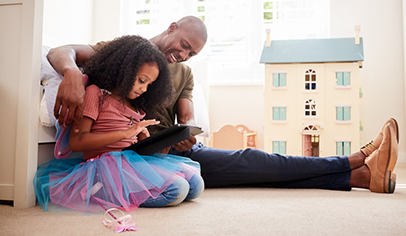Screen Time: the good, the bad, and the balance
Unlock the benefits to screen time. The key is striking a balance.
February 13, 2022

stockbroker/123RF
Technology is everywhere and exploding.
Education and technology have been slowly merging for years. As we all know, the pandemic merged these two quicker than planned, and it seems as though this newfound education is here to stay. Many schools are one-to-one with devices, meaning every student has their own school device.
Whether it is a tablet or a laptop, our children have their eyes on a screen for a part of the school day.
The good and the bad
Having their own device at school allows students to take a more personal approach to learning. They can excel on school-bought educational apps at their own pace and level. If they are having trouble with a concept, teachers can find and provide different ways to hone in on those concepts and allow more practice time to perfect the skill. From apps to shared workspaces and digital worksheets, devices and the digital space allows far more growth than ever before.
- It prepares them for the future. Their lives are engulfed in technology. Learning how to use technology prepares these students for the world they will live and work in. This will be especially important later on when teaching your children about media literacy and internet safety.
- They can go places that would otherwise be impossible without the technology. For example, they can go on virtual field trips to museums, connect through digital platforms with an author, etc. The opportunities are vast.
- They learn digital citizenship. They see what technology is capable of, and they are taught the appropriate ways to use it.
- On the contrary, having their own device takes away social interaction when they are using it. Creation, imagination, and hands-on learning is also hindered.
- Developmental issues are a concern as well. Too much screen time can affect development and behavior, and the blue light emitted from the devices can affect the eyes.
So, how much is too much screen time?
The recommended amount of screen time a child receives each day depends on their age and what screen time they are engaging with. A general rule is to find a healthy balance in proportion to the rest of their activities. Research also suggests allowing less time during the school week, when children are engaged with screen time during the school day.
Regulating screen time
Remember, parents are in charge. Pay attention. How much are they using their device? How do they react when their device is taken away? While you may not be able to control school screen time (although, you can encourage breaks), you are in control of that screen time when they are home.
Here are some tips to help strike a balance with screen time at home:
- Talk about time limits and set a timer when they engage with recreational screen time.
Remind them of their time limit to avoid an abrupt ending. - “Draw them out” of their screen time a few minutes before their time is up by participating in it and discussing it. Studies show this makes it easier for children to disengage with their device.
- Be involved in their screen time. Make sure you know what they are doing and engaging with. Talk to them about it, and join in it with them.
- Encourage them learn more about their own interests with their devices like nature, art, sports, etc.. Designate some time for them to engage with that interest outside of the digital space. Bring them to a museum, a zoo, or practice basketball with them, and point out the things they’ve been learning about online. This will help your child view technology as a supplement to their life instead of the main focal point.
- Utilize parental controls on the devices and/or download software to control screen time.
- Designate which areas—inside and outside of the home—are device-friendly and which are screen-free zones.
- Set times for device use. When are they allowed to use their devices? Research suggests devices be shut off at least two hours prior to bedtime for proper sleep.
- Be a role model. Use your devices in the same fashion you want your children to use theirs.
- Keep them busy. Planned activities, family time, crafts, extra-curricular activities, etc. will keep their minds busy and away from their devices. Focusing on screen-free activities will naturally lessen screen time, instead of focusing on restricting the screen time with no alternatives.
Technology is inevitable and unavoidable. Remember the good and the bad. Pay attention. Nurture screen-free activities, and strike a balance as balance is the key.
Get your child's exact back‑to‑school supply list, right from their teacher.



